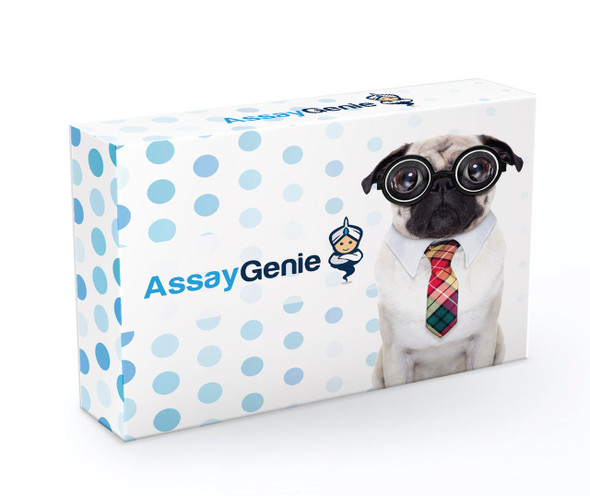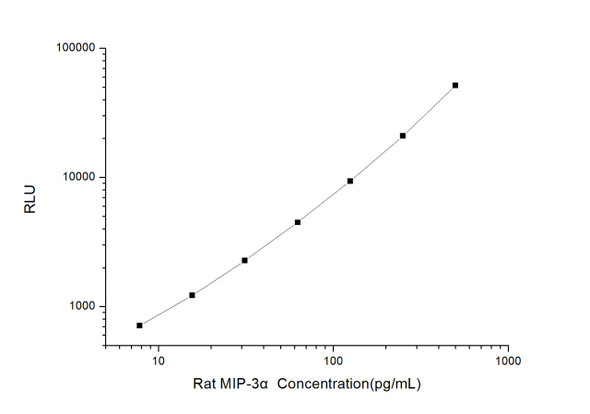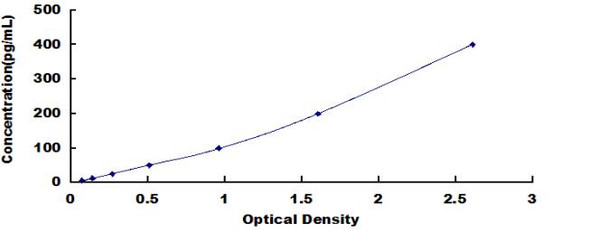Human MIP-3 alpha (Macrophage Inflammatory Protein 3 Alpha) ELISA Kit (HUES01314)
- SKU:
- HUES01314
- Product Type:
- ELISA Kit
- Size:
- 96 Assays
- Uniprot:
- P78556
- Sensitivity:
- 9.38pg/mL
- Range:
- 15.63-1000pg/mL
- ELISA Type:
- Sandwich
- Synonyms:
- CCL20, CKb4, LARC, MIP3A, SCYA20, ST38
- Reactivity:
- Human
- Sample Type:
- Serum, plasma and other biological fluids
- Research Area:
- Cell Biology
Description
Human MIP-3 alpha (Macrophage Inflammatory Protein 3 Alpha) ELISA Kit
The Human MIP-3 Alpha (Macrophage Inflammatory Protein 3 Alpha) ELISA Kit is a valuable tool for the precise measurement of MIP-3 Alpha levels in human samples including serum, plasma, and cell culture supernatants. This kit is known for its high sensitivity and specificity, ensuring accurate and consistent results for a variety of research applications.MIP-3 Alpha is a key chemokine involved in the recruitment and activation of immune cells, particularly macrophages.
It plays a crucial role in inflammatory responses and immune cell trafficking, making it an important target for studying conditions such as inflammatory diseases, autoimmune disorders, and infectious diseases.By using the Human MIP-3 Alpha ELISA Kit, researchers can effectively investigate the role of MIP-3 Alpha in various biological processes and diseases, ultimately contributing to the development of new therapeutic strategies and diagnostic tools.
| Assay type: | Sandwich |
| Format: | 96T |
| Assay time: | 4.5h |
| Reactivity: | Human |
| Detection Method: | Colormetric |
| Detection Range: | 15.63-1000 pg/mL |
| Sensitivity: | 9.38 pg/mL |
| Sample Volume Required Per Well: | 100µL |
| Sample Type: | Serum, plasma and other biological fluids |
| Specificity: | This kit recognizes Human MIP-3 alpha in samples. No significant cross-reactivity or interference between Human MIP-3 alpha and analogues was observed. |
This ELISA kit uses Sandwich-ELISA as the method. The micro ELISA plate provided in this kit has been pre-coated with an antibody specific to Human MIP-3 alpha. Standards or samples are added to the appropriate micro ELISA plate wells and combined with the specific antibody. Then a biotinylated detection antibody specific for Human MIP-3 alpha and Avidin-Horseradish Peroxidase (HRP) conjugate are added to each micro plate well successively and incubated. Free components are washed away. The substrate solution is added to each well. Only those wells that contain Human MIP-3 alpha, biotinylated detection antibody and Avidin-HRP conjugate will appear blue in color. The enzyme-substrate reaction is terminated by adding Stop Solution and the color turns yellow. The optical density (OD) is measured spectrophotometrically at a wavelength of 450 nm ± 2 nm. The OD value is proportional to the concentration of Human MIP-3 alpha. The concentration of Human MIP-3 alpha in samples can be calculated by comparing the OD of the samples to the standard curve.
| UniProt Protein Function: | CCL20: Chemotactic factor that attracts lymphocytes and, slightly, neutrophils, but not monocytes. Inhibits proliferation of myeloid progenitors in colony formation assays. May be involved in formation and function of the mucosal lymphoid tissues by attracting lymphocytes and dendritic cells towards epithelial cells. C-terminal processed forms have been shown to be equally chemotactically active for leukocytes. Possesses antibacterial activity E. coli ATCC 25922 and S. aureus ATCC 29213. Belongs to the intercrine beta (chemokine CC) family. 2 isoforms of the human protein are produced by alternative splicing. |
| UniProt Protein Details: | Protein type:Chemokine; Secreted; Secreted, signal peptide; Motility/polarity/chemotaxis Chromosomal Location of Human Ortholog: 2q36. 3 Cellular Component: extracellular space; extracellular region Molecular Function:protein binding; chemokine activity Biological Process: cell-cell signaling; wound healing; defense response to bacterium; immune response; chemotaxis; inflammatory response; signal transduction; positive regulation of interleukin-1 alpha biosynthetic process; positive regulation of nitric-oxide synthase biosynthetic process |
| NCBI Summary: | This antimicrobial gene belongs to the subfamily of small cytokine CC genes. Cytokines are a family of secreted proteins involved in immunoregulatory and inflammatory processes. The CC cytokines are proteins characterized by two adjacent cysteines. The protein encoded by this gene displays chemotactic activity for lymphocytes and can repress proliferation of myeloid progenitors. Two transcript variants encoding different isoforms have been found for this gene. [provided by RefSeq, Sep 2014] |
| UniProt Code: | P78556 |
| NCBI GenInfo Identifier: | 2829668 |
| NCBI Gene ID: | 6364 |
| NCBI Accession: | P78556. 1 |
| UniProt Secondary Accession: | P78556,Q53S51, Q99664, |
| UniProt Related Accession: | P78556 |
| Molecular Weight: | 10,691 Da |
| NCBI Full Name: | C-C motif chemokine 20 |
| NCBI Synonym Full Names: | chemokine (C-C motif) ligand 20 |
| NCBI Official Symbol: | CCL20 |
| NCBI Official Synonym Symbols: | CKb4; LARC; ST38; MIP3A; Exodus; MIP-3a; SCYA20; MIP-3-alpha |
| NCBI Protein Information: | C-C motif chemokine 20; CC chemokine LARC; beta chemokine exodus-1; small-inducible cytokine A20; macrophage inflammatory protein 3 alpha; liver and activation-regulated chemokine; small inducible cytokine subfamily A (Cys-Cys), member 20 |
| UniProt Protein Name: | C-C motif chemokine 20 |
| UniProt Synonym Protein Names: | Beta-chemokine exodus-1; CC chemokine LARC; Liver and activation-regulated chemokine; Macrophage inflammatory protein 3 alpha; MIP-3-alpha; Small-inducible cytokine A20Cleaved into the following 3 chains:CCL20(1-67); CCL20(1-64); CCL20(2-70) |
| Protein Family: | C-C motif chemokine |
| UniProt Gene Name: | CCL20 |
| UniProt Entry Name: | CCL20_HUMAN |
As the OD values of the standard curve may vary according to the conditions of the actual assay performance (e. g. operator, pipetting technique, washing technique or temperature effects), the operator should establish a standard curve for each test. Typical standard curve and data is provided below for reference only.
| Concentration (pg/mL) | O.D | Average | Corrected |
| 1000 | 2.495 2.507 | 2.501 | 2.425 |
| 500 | 1.552 1.602 | 1.577 | 1.501 |
| 250 | 0.942 0.918 | 0.93 | 0.854 |
| 125 | 0.468 0.494 | 0.481 | 0.405 |
| 62.5 | 0.246 0.238 | 0.242 | 0.166 |
| 31.25 | 0.19 0.164 | 0.177 | 0.101 |
| 15.63 | 0.125 0.131 | 0.128 | 0.052 |
| 0 | 0.069 0.083 | 0.076 | -- |
Precision
Intra-assay Precision (Precision within an assay): 3 samples with low, mid range and high level Human MIP-3 alpha were tested 20 times on one plate, respectively.
Inter-assay Precision (Precision between assays): 3 samples with low, mid range and high level Human MIP-3 alpha were tested on 3 different plates, 20 replicates in each plate.
| Intra-assay Precision | Inter-assay Precision | |||||
| Sample | 1 | 2 | 3 | 1 | 2 | 3 |
| n | 20 | 20 | 20 | 20 | 20 | 20 |
| Mean (pg/mL) | 45.85 | 150.65 | 423.98 | 42.63 | 160.97 | 412.36 |
| Standard deviation | 2.31 | 7.08 | 15.14 | 2.88 | 6.99 | 19.63 |
| C V (%) | 5.04 | 4.70 | 3.57 | 6.76 | 4.34 | 4.76 |
Recovery
The recovery of Human MIP-3 alpha spiked at three different levels in samples throughout the range of the assay was evaluated in various matrices.
| Sample Type | Range (%) | Average Recovery (%) |
| Serum (n=5) | 91-108 | 99 |
| EDTA plasma (n=5) | 86-96 | 91 |
| Cell culture media (n=5) | 89-102 | 94 |
Linearity
Samples were spiked with high concentrations of Human MIP-3 alpha and diluted with Reference Standard & Sample Diluent to produce samples with values within the range of the assay.
| Serum (n=5) | EDTA plasma (n=5) | Cell culture media (n=5) | ||
| 1:2 | Range (%) | 89-103 | 86-96 | 85-101 |
| Average (%) | 94 | 91 | 92 | |
| 1:4 | Range (%) | 92-108 | 86-98 | 83-95 |
| Average (%) | 99 | 92 | 90 | |
| 1:8 | Range (%) | 90-106 | 86-100 | 84-97 |
| Average (%) | 96 | 93 | 89 | |
| 1:16 | Range (%) | 90-103 | 82-93 | 84-96 |
| Average (%) | 97 | 87 | 89 |
An unopened kit can be stored at 4°C for 1 month. If the kit is not used within 1 month, store the items separately according to the following conditions once the kit is received.
| Item | Specifications | Storage |
| Micro ELISA Plate(Dismountable) | 8 wells ×12 strips | -20°C, 6 months |
| Reference Standard | 2 vials | |
| Concentrated Biotinylated Detection Ab (100×) | 1 vial, 120 µL | |
| Concentrated HRP Conjugate (100×) | 1 vial, 120 µL | -20°C(shading light), 6 months |
| Reference Standard & Sample Diluent | 1 vial, 20 mL | 4°C, 6 months |
| Biotinylated Detection Ab Diluent | 1 vial, 14 mL | |
| HRP Conjugate Diluent | 1 vial, 14 mL | |
| Concentrated Wash Buffer (25×) | 1 vial, 30 mL | |
| Substrate Reagent | 1 vial, 10 mL | 4°C(shading light) |
| Stop Solution | 1 vial, 10 mL | 4°C |
| Plate Sealer | 5 pieces | |
| Product Description | 1 copy | |
| Certificate of Analysis | 1 copy |
- Set standard, test sample and control (zero) wells on the pre-coated plate and record theirpositions. It is recommended to measure each standard and sample in duplicate. Note: addall solutions to the bottom of the plate wells while avoiding contact with the well walls. Ensuresolutions do not foam when adding to the wells.
- Aliquot 100 µL of standard solutions into the standard wells.
- Add 100 µL of Sample / Standard dilution buffer into the control (zero) well.
- Add 100 µL of properly diluted sample (serum, plasma, tissue homogenates and otherbiological fluids) into test sample wells.
- Cover the plate with the sealer provided in the kit and incubate for 90 min at 37 °C.
- Aspirate the liquid from each well, do not wash. Immediately add 100 µL of BiotinylatedDetection Ab working solution to each well. Cover the plate with a plate seal and gently mix. Incubate for 1 hour at 37 °C.
- Aspirate or decant the solution from the plate and add 350 µL of wash buffer to each welland incubate for 1-2 minutes at room temperature. Aspirate the solution from each well andclap the plate on absorbent filter paper to dry. Repeat this process 3 times. Note: a microplatewasher can be used in this step and other wash steps.
- Add 100 µL of HRP Conjugate working solution to each well. Cover with a plate seal andincubate for 30 min at 37 °C.
- Aspirate or decant the solution from each well. Repeat the wash process for five times asconducted in step 7.
- Add 90 µL of Substrate Reagent to each well. Cover with a new plate seal and incubate forapproximately 15 min at 37 °C. Protect the plate from light. Note: the reaction time can beshortened or extended according to the actual color change, but not by more than 30min.
- Add 50 µL of Stop Solution to each well. Note: Adding the stop solution should be done inthe same order as the substrate solution.
- Determine the optical density (OD value) of each well immediately with a microplate readerset at 450 nm.






